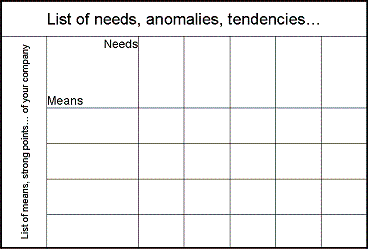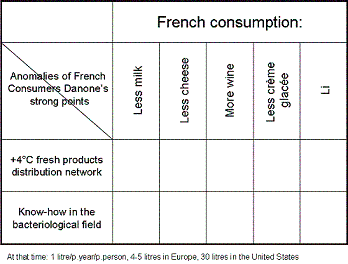CLASS
B
PHASE
DESCRIPTION
Discovery Matrix is a method developed by Michel Joly (1993); it is based upon a list of needs and a list of means (which are a company “strong points”). You cross the two lists by means of a matrix and generate new ideas from every casual intersection of means and needs. (Figure 3-3)

Figure 3-3 Discovery matrix (Source: Joly, 1993)
Three different matrix versions can be used:
- Rectangular Matrix: it is used to match lists of needs and lists of means (most common lists);
- Square matrix: it is made up of two identical lists and it is used to understand the “what for” of a particular product or process. This approach offers more chances to find interesting and innovative solutions, as it combines two patterns instead of working on one at a time.
- Three-dimensional Matrix: it expands square matrix, as it considers three patterns instead of two.
“ Approximately in the year 1968 Danone – which was not in partnership with Gervais yet – was looking for a new food product.
So a creativity group with an external leader started to cooperate to develop a new matrix.
They could easily find the necessary means and outline a strategy for Danone. They only needed to identify their strong points and compare them to those of the competition. It resulted that Danone had laboratories well equipped with bacteriological experts, a number of lorries for +4°C deliveries, an excellent image, many distributors, etc.
However, they found it harder to identify the company needs...Yet, an irreversible global phenomen was taking place worldwide in the food sector: food habits of people living in opposite parts of the world were more and more similar, because they could communicate and exchange information more easily, etc.
The market-oriented Danone group was therefore to identify the anomalies of French consumers, id. food products that were less consumed in France at that time in comparison with other countries...
They estimated that the French consumed less cold pork meat than the German, less crème glacée (0,8 litres p.person, p.year) than the Swedes (4-6 litres) or than the Americans (32 litres) and finally less milk than the British, etc.
According to this data, they generated the matrix [Figure 3-4].
When I happen to suggest this matrix to one of my creativity groups, I warn them to start from the cause that establishes a connection between our future increased consumption of crème glacée and the +4°C lorries.
[…] Ideas become more focused: I am not able to deliver ice-cream; so, if people begin to eat more ice-cream they would better keep it in their refrigerator. The idea came out naturally: consumers had to be provided with a particular crème glacée for cool storage. This idea - called Danino – turned out to be brilliant (its success was later confirmed by the turnover).” (Joly, 1993)

Figure 3-4: Danone Discovery matrix (Source: Joly, 1993)
CORRELATE
TECHNIQUES
REFERENCES
-
Joly M., Des idées qui repportent... ca se trouve! Démystifier la créativité industrielle, Paris, Les Éditions d'Organisation, 1992.
-
Jaoui H., La creativité mode d'emploi, Paris, ESF éditeur-Enterprise Moderne d'Edition et Libraires Techniques, 1990.